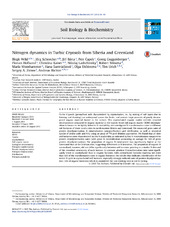| dc.contributor.author | Wild, Birgit | eng |
| dc.contributor.author | Schnecker, Jörg | eng |
| dc.contributor.author | Bárta, Jiří | eng |
| dc.contributor.author | Čapek, Petr | eng |
| dc.contributor.author | Guggenberger, Georg | eng |
| dc.contributor.author | Hofhansl, Florian | eng |
| dc.contributor.author | Kaiser, Christina | eng |
| dc.contributor.author | Lashchinsky, Nikolaj | eng |
| dc.contributor.author | Mikutta, Robert | eng |
| dc.contributor.author | Mooshammer, Maria | eng |
| dc.contributor.author | Šantrůčková, Hana | eng |
| dc.contributor.author | Shibistova, Olga | eng |
| dc.contributor.author | Urich, Tim | eng |
| dc.contributor.author | Zimov, Sergey A. | eng |
| dc.contributor.author | Richter, Andreas | eng |
| dc.date.accessioned | 2015-04-13T07:53:36Z | |
| dc.date.available | 2015-04-13T07:53:36Z | |
| dc.date.issued | 2013-12 | eng |
| dc.identifier.issn | 0038-0717 | en_US |
| dc.identifier.uri | http://hdl.handle.net/1956/9765 | |
| dc.description.abstract | Turbic Cryosols (permafrost soils characterized by cryoturbation, i.e., by mixing of soil layers due to freezing and thawing) are widespread across the Arctic, and contain large amounts of poorly decomposed organic material buried in the subsoil. This cryoturbated organic matter exhibits retarded decomposition compared to organic material in the topsoil. Since soil organic matter (SOM) decomposition is known to be tightly linked to N availability, we investigated N transformation rates in different soil horizons of three tundra sites in north-eastern Siberia and Greenland. We measured gross rates of protein depolymerization, N mineralization (ammonification) and nitrification, as well as microbial uptake of amino acids and NH4+ using an array of 15N pool dilution approaches. We found that all sites and horizons were characterized by low N availability, as indicated by low N mineralization compared to protein depolymerization rates (with gross N mineralization accounting on average for 14% of gross protein depolymerization). The proportion of organic N mineralized was significantly higher at the Greenland than at the Siberian sites, suggesting differences in N limitation. The proportion of organic N mineralized, however, did not differ significantly between soil horizons, pointing to a similar N demand of the microbial community of each horizon. In contrast, absolute N transformation rates were significantly lower in cryoturbated than in organic horizons, with cryoturbated horizons reaching not more than 32% of the transformation rates in organic horizons. Our results thus indicate a deceleration of the entire N cycle in cryoturbated soil horizons, especially strongly reduced rates of protein depolymerization (16% of organic horizons) which is considered the rate-limiting step in soil N cycling. | en_US |
| dc.language.iso | eng | eng |
| dc.publisher | Elsevier | en_US |
| dc.rights | Attribution CC BY | eng |
| dc.rights.uri | http://creativecommons.org/licenses/by/3.0/ | eng |
| dc.subject | Arctic | eng |
| dc.subject | Tundra | eng |
| dc.subject | Cryoturbation | eng |
| dc.subject | Soil organic matter | eng |
| dc.subject | Ecological stoichiometry | eng |
| dc.subject | Nitrogen transformation | eng |
| dc.subject | Protein depolymerization | eng |
| dc.subject | Nitrogen mineralization | eng |
| dc.subject | Nitrification | eng |
| dc.subject | Nitrogen availability | eng |
| dc.title | Nitrogen dynamics in Turbic Cryosols from Siberia and Greenland | en_US |
| dc.type | Peer reviewed | |
| dc.type | Journal article | |
| dc.date.updated | 2015-04-01T08:35:28Z | en_US |
| dc.description.version | publishedVersion | en_US |
| dc.rights.holder | Copyright 2014 The Authors | en_US |
| dc.identifier.doi | https://doi.org/10.1016/j.soilbio.2013.08.004 | |
| dc.identifier.cristin | 1098458 | |
| dc.source.journal | Soil Biology and Biochemistry | |
| dc.source.40 | 67 | |
| dc.source.pagenumber | 85-93 | |
| dc.subject.nsi | VDP::Mathematics and natural scienses: 400::Zoology and botany: 480::Ecology: 488 | en_US |
| dc.subject.nsi | VDP::Mathematics and natural scienses: 400::Geosciences: 450::Physical geography: 455 | en_US |
| dc.subject.nsi | VDP::Matematikk og naturvitenskap: 400::Geofag: 450::Naturgeografi: 455 | nob |
| dc.subject.nsi | VDP::Matematikk og naturvitenskap: 400::Zoologiske og botaniske fag: 480::Økologi: 488 | nob |

